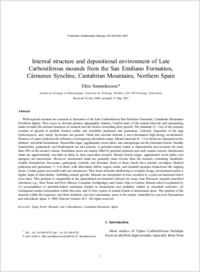Internal structure and depositional environment of Late Carboniferous mounds from the San Emiliano Formation, Cármenes Syncline, Cantabrian Mountains, Northern Spain
- Samankassou, Elias Department of Geosciences, University of Fribourg, Switzerland
-
2001
Published in:
- Sedimentary Geology. - 2001, vol. 145, no. 3-4, p. 235-252
English
Well-exposed mounds are common in limestone of the Late Carboniferous San Emiliano Formation, Cantabrian Mountains (Northern Spain). They occur as obvious primary topographic features. Careful study of the mound intervals and surrounding strata revealed the internal structures of mounds and the factors controlling their growth. The substrate (2–3 m) of the mounds consists of greyish to reddish, bedded oolitic and oncolithic packstone and grainstone. Crinoids, fragments of the alga Epimastopora, and, rarely, bryozoans are present. Ooids and oncoids indicate a wave-dominated high-energy environment. Presence of quartz indicates the influence of terrigenous siliciclastic input. Mound intervals (6–12 m thick) are characterized by skeletal–microbial boundstone. Donezellid algae, agglutinated worm tubes, and calcisponges are the dominant fossils. Smaller foraminifers, gastropods, and brachiopods are also present. A peloidal-clotted matrix is characteristic and accounts for more than 30% of the mound volume. Intraframe pores are mainly filled by peloidal sediment and early marine cement. Intermound strata are approximately one-third as thick as time equivalent mounds. Mound fossils (algae, agglutinated worm tubes, and sponges) are uncommon. However, intermound strata are generally more diverse than the mounds, containing fusulinids, smaller foraminifers, bryozoans, gastropods, crinoids, and bioclasts. Some of these fossils have micritic envelopes. Bedded packstone and grainstone, 3–6 m thick, with siliciclastic debris, rugose corals, and chaetetid sponges characterize the capping facies. Coated grains and small ooids are uncommon. This facies indicates shallowing to a higher energy environment and/or a higher input of siliciclastics, inhibiting mound growth. Mounds are interpreted to have accreted in a quiet environment below wave base. This position is comparable to the depositional environment inferred for many Late Paleozoic mounds described elsewhere, e.g., from Texas and New Mexico, Canadian Archipelago, and Carnic Alps in Austria. Mound relief is explained by (1) accumulation of peloidal-clotted sediments limited to boundstone and probably related to microbial activities, (2) widespread marine cementation within this area, and (3) low export of mound fossils to intermound areas. The position of the mounds within the sequence, and their initiation, size and termination, seem to be mainly controlled by sea-level fluctuations and siliciclastic input.
- Faculty
- Faculté des sciences et de médecine
- Department
- Département de Géosciences
- Language
-
- English
- Classification
- Geology
- License
- License undefined
- Identifiers
-
- RERO DOC 4948
- DOI 10.1016/S0037-0738(01)00150-6
- Persistent URL
- https://folia.unifr.ch/unifr/documents/299588
Statistics
Document views: 85
File downloads:
- 1_samankassou_isd.pdf: 835
